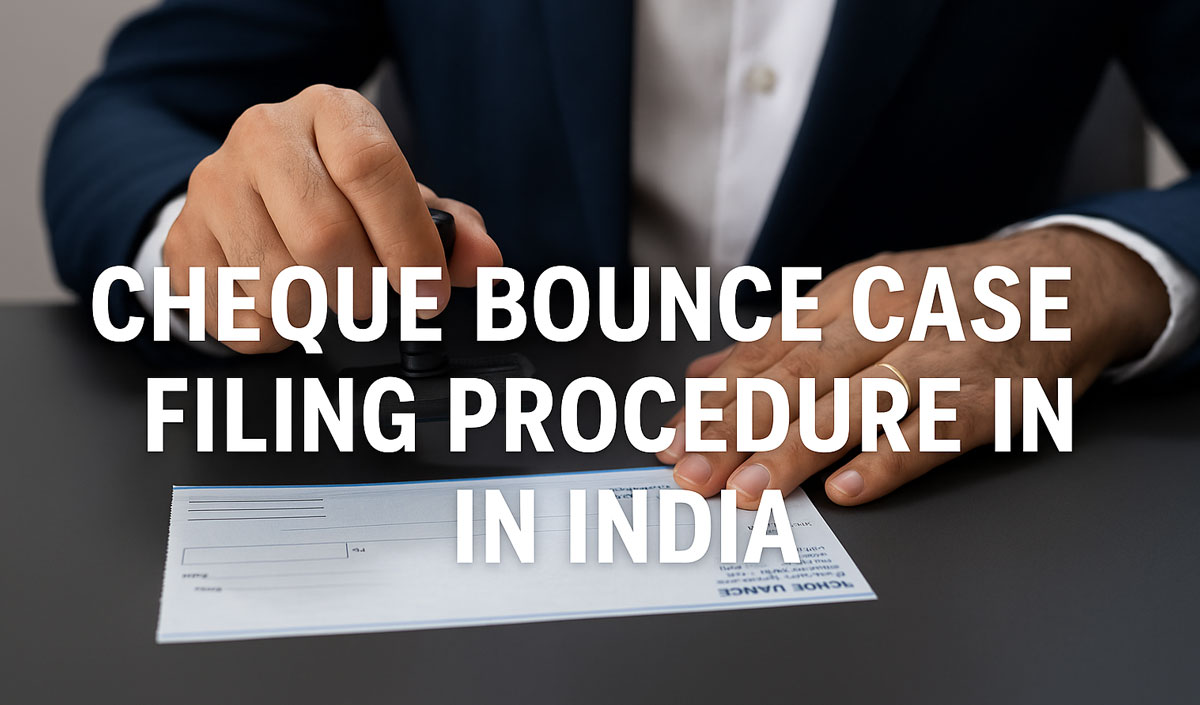Have you received a cheque that bounced? You’re not alone. With the rise of digital payments, cheques are less common—but when they do bounce, the consequences can be serious.
In India, a bounced cheque isn’t just a financial inconvenience—it’s a criminal offence under Section 138 of the Negotiable Instruments Act.
This provision was added to the original 1881 Act through the Banking, Public Financial Institutions and Negotiable Instruments Laws (Amendment) Act, 1988, which came into force on March 29, 1989.
If you’ve received a cheque that didn’t clear, you can file a legal case and recover your money, with the offender facing potential imprisonment of up to two years and fines up to twice the cheque amount.
This blog explains the “Cheque Bounce Case Filing Procedure in India” in simple, step-by-step terms. Whether you’re a business owner, freelancer, or individual, this 2025 guide will help you file your case the right way.
What Is Cheque Bounce Under Indian Law?
When a cheque issued to you is returned unpaid by the bank due to:
- Insufficient funds
- Account closed
- Signature mismatch
- The drawer stopped the Payment
It’s called a cheque dishonour or cheque bounce. Under Section 138 of the NI Act, this is a punishable offence.
The drawer (person who issued the cheque) can face:
- 🕒 Up to 2 years of imprisonment
- 💰 Fine up to double the cheque amount
- 📜 Criminal record + legal consequences
Step-by-Step: Cheque Bounce Case Filing Procedure in India
Step 1: Get Cheque Return Memo from the Bank
Once the cheque is dishonoured, the bank will issue a written memo stating the reason for return. This is your first legal proof.
Step 2: Send Legal Notice Within 30 Days
You must send a formal legal notice to the drawer:
- Within 30 days of receiving the cheque return memo
- Via Registered Post / Speed Post / Courier with tracking
- Keep a copy of the notice & proof of delivery
The notice must include:
- Details of the cheque (number, amount, date)
- Reason for dishonour
- Request for payment within 15 days
- Warning of legal action if unpaid
Tip: Get a lawyer to draft this notice. Courts reject informal or incomplete notices.
Step 3: Wait for 15 Days
The law gives the drawer 15 days from receiving the notice to make the payment. If they don’t, you become eligible to file a case.
Step 4: File the Complaint in Court Within 30 Days
If payment is still not made, file a criminal complaint under Section 138 within 30 days from the expiry of the 15 days.
You need to file the case in the Magistrate Court (usually JMFC or MM Court) with territorial jurisdiction where your bank is located.
Step 5: Attend Court Hearings
The court will:
- Issue summons to the drawer
- Record your statement
- Ask for document evidence
- Hear the accused’s version
If proven guilty, the court may award compensation, a fine, or imprisonment to the drawer.
Documents Required to File a Cheque Bounce Case
- Original bounced cheque
- Cheque return memo from the bank
- Copy of legal notice & delivery proof
- Any correspondence or communication
- Proof of transaction (invoice, agreement, etc.)
Having these ready makes your case stronger and faster.
Timeline for Filing a Cheque Bounce Case
| Event | Time Limit |
|---|---|
| Cheque dishonoured | Day 0 |
| Send legal notice | Within 30 days |
| Wait for payment | 15 days |
| File a court case | Within the next 30 days |
What Happens After Filing the Case?
Summons Issued:
The accused is summoned to appear before the court.
Accused’s Plea:
If they plead guilty, the case may close with a fine/compensation. If not, the trial begins.
Evidence Stage:
- You submit a cheque, memo, notice, etc.
- You may be cross-examined by the accused’s lawyer
Judgment:
If found guilty, the court can order:
- Fine (up to double the cheque amount)
- Compensation to you
- Imprisonment up to 2 years
Can You Settle Out of Court?
Yes. You can settle the matter any time before judgment. Many cheque bounce cases are resolved through negotiation, part payments, or written settlements.
If a settlement happens, inform the court through a joint application.
Can You File a Civil Case Too?
Yes, a civil suit for recovery is also possible, especially if you want:
- Recovery with interest
- Attachment of assets or bank accounts
You can file both civil and criminal cases, but the process and purpose are different.
FAQs on Cheque Bounce Case Filing in India
Q. Can I file the case after 30 days?
Only with a valid reason and court permission. Otherwise, the case may be rejected.
Q. What if the drawer has left town or is missing?
You can request a non-bailable warrant after a summons is ignored repeatedly.
Q. Can post-dated cheques be filed under 138?
Yes, if issued against a legally enforceable debt or liability.
Q. Do I need a lawyer?
Technically, no. But practically, yes—Section 138 cases are legal and require strong drafting and presentation.
Protect Your Money with the Right Legal Steps
Filing a cheque bounce case in India isn’t difficult—but it’s time-sensitive and procedural. The earlier you act, the stronger your case.
Whether you’re a small business, freelancer, landlord, or supplier—don’t let bounced cheques go unchallenged. The law is on your side if you follow the process.
Need Help Filing a Cheque Bounce Case?
I help individuals and businesses across India draft notices, file cases, and recover money through legal action.
📩 Reach out today and let’s file your case before time runs out.

